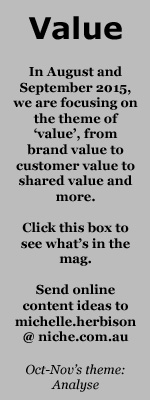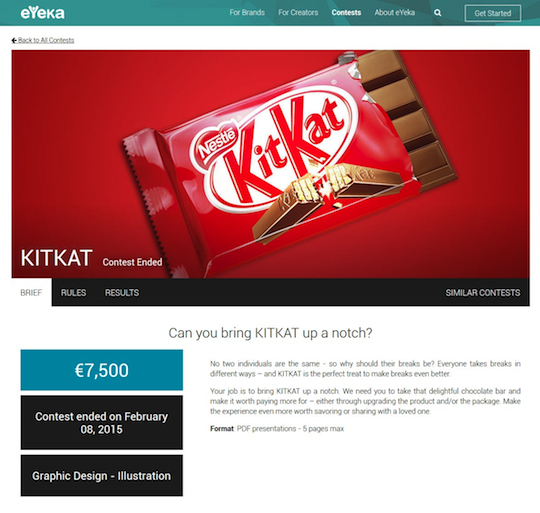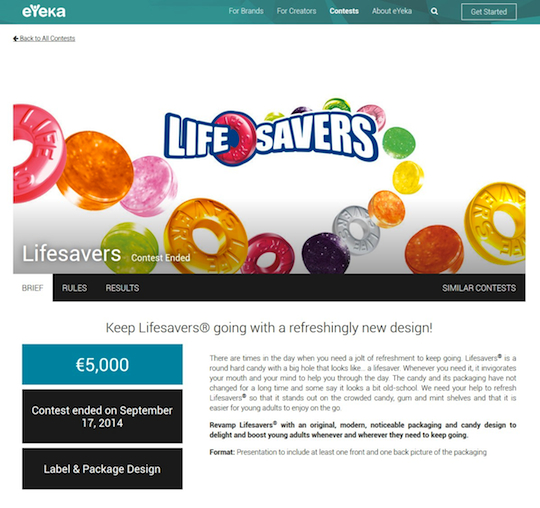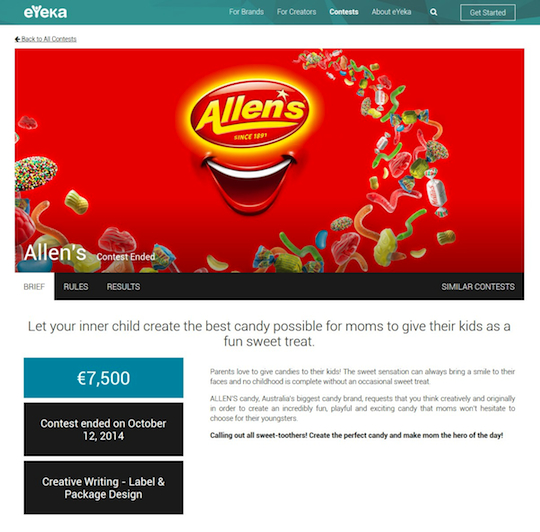Nestle explains why it’s crowdsourcing ideas for KitKat, Allen’s lollies and Lifesavers
Share
 Nestle is the latest big brand using a crowdsourcing platform to collect fresh ideas around new product development, packaging and communication strategies.
Nestle is the latest big brand using a crowdsourcing platform to collect fresh ideas around new product development, packaging and communication strategies.
The FMCG giant is using eYeka, a global crowdsourcing platform that calls itself ‘the world’s biggest community playground’, connecting client briefs with a more than 300,000 creatives in 164 countries speaking more than 10 different languages.
Nestle started out testing the platform with Lifesavers, opening up a brief to the community in the form of a competition. They received so many great ideas that they decided to expand, sending out additional briefs for the KitKat and Allen’s brands.
eYeka’s head in ANZ, Matthieu Jacomin, explains how it works:
“It’s always a competition, so we open the brief to the whole community, we set up at the beginning a number of winners, between three to five winners, and at the end of the day when we present the work and the ideas to the brand they have access to all of them and they have to select winners and give them a prize to buy the IP of the ideas.”
Regular community members as well as outsiders are invited to “crack the brief” for the promise of a monetary prize if they win.
The community includes creative advertising professionals, freelancers, students and what Jacomin calls ‘people in the wrong job’ who use it as a chance to express their creativity.
“We don’t segment the brief,” he explains. “The philosophy of crowdsourcing is that the best ideas can come from anywhere, and it’s a way for brands to address or engage with what we call the creative consumers, which is 1% of the population, to create fresh ideas.
“If a good idea comes from Brazil, Australia, Netherlands or France, you don’t care. It’s a good idea and you want to test it with what the people who are your consumers, you’ll then go to test the idea in a focus group or panel.”
Nestle is still in the development phase of its new Lifesavers, KitKat and Allen’s strategies, so they can’t talk specifics just yet, but the crowdsourcing concept has been successful at generating more ideas than the team could have hoped for.
Chris O’Donnell, Nestle Australia’s head of marketing for confectionary and snacks, talks to Michelle Herbison about why the team decided to try eYeka and what the brand has got out of it so far.
Marketing: What was the strategy behind using crowdsourcing as a way to source ideas and to launch new products or product extensions?
Chris O’Donnell: We’ve actually done three crowdsourcing projects now, for KitKat, Lifesavers and Allen’s. Overall what we’re trying to do within Nestle is look at new ways of unlocking ideas. That’s both in terms of what we’re doing within the organisation, but also how we’re using organisations like eYeka to give us access to global creative people and also consumers to give us new ideas, whether that be on innovation, packaging design or communications.
M: Have you found that crowdsourcing is a good way to get an external point of view and some new ideas?
CO: Yes, and I think we’re constantly looking at how we can get that external perspective, whether that be through what we’ve done in social media but also i think this provides us with a structured platform based on a very tightly-defined brief and strategy for our brand. We’re looking at how we can broaden the spectrum of ideas and get new ideas into the business.
M: Are there any other benefits of using this kind of process, such as saving money?
CO: Definitely in terms of creativity; getting different thinking. Number two would be speed; the pace at which we can brief in, get a response back – a structured response of high quality ideas, is no doubt a key benefit, and we can work within a space of probably four to five weeks of brief to turnaround. And no doubt in terms of cost, so the actual savings versus if we were to run a much more structured ideation or communication process, is no doubt one of the elements attracting us to this platform.
M: Can we run through the three projects in order and get a bit more detail around what they involved?
CO: There were three briefs we put in. The first was on Lifesavers, and this one was really looking at how we can rejuvenate a well-known Australian iconic brand. Lifesavers is well-known, and we were looking at new ways of unlocking innovation in communication and also packaging. We were really surprised at the breadth of ideas. Very creative, from all over the world, that went beyond just pure product innovation – that really looked at a whole host of ideas that we could rejuvenate Lifesavers.
Allens was all about how we can unlock innovation and bring to life new innovative ways of delivering lollies to consumers. But we were trying to make sure that we could do so in a very responsible way, so part of our strategy is all about delivering consumers with better and more informed nutrition information, so balancing fun and what we call ‘permissibility’ was a key dimension of the Allens brief.
KitKat was all about how we unlock new break occasions. It’s a well-known brand, and in a global network of eYeka we’ve been able to tap into consumers who had consumed and know the brand from all over the world, and look at different ways which we can bring new formats, and new ways of delighting consumers in their break.
M: What kind of response did you get for each of them? What ideas and what kind of people were responding?
CO: Across all of it, we’ve got hundreds of ideas, and I think it was probably difficult to identify the top 10, and the team worked through that then came to us with all of the ideas, and their recommendations on what they believed were the winning content. But we got a whole spectrum of ideas from new products to packaging design to activation, in-store materials, communication ideas… we were able to get a really broad set of ideas, and that went beyond what we’d originally requested in the brief. That really comes down to the creativity of the consumers or the people within the network. We got responses from all over the world, from pretty much every corner of the globe.
M: How did you go about actually choosing between the ideas? It sounds like you got some really great ideas, and more than you expected. How did you sift through it all?
CO: With great difficulty, in short. Lots of really good ideas, and I guess for me what it all comes back to is what delivers to the brief. We had the opportunity to buy the IP, and in some instances we bought more than what we’d originally planned and what we’d expected because the ideas were good. But really it comes down to what we feel is going to be most closely associated and aligned to the brief, and what we think is really going to help drive growth for us in the future.
M: Can you share some of the ideas and go into a bit more detail of what you ended up with?
CO: I won’t be able to go into detail of the ideas, we only just did this over the past 12 months, so we’re still in the process of working through those.
There were ideas that related to point-of-sale, to packaging, to product innovation, to communications, so we got a number of different start points. But we haven’t actually brought to market, so we’re still in the confidential phase.
M: So why did you decide to do the same process with three different brands, rather than starting it off testing it with one and seeing how it goes through the whole process?
CO: That’s actually what we did. The start-point for us was testing this. Really understanding whether we felt the investment in crowdsourcing was going to deliver us new ideas into the business. We actually started on Lifesavers, and we were amazed, lots of really great ideas. And that gave us confidence to go to our two more strategic brands – KitKat and Allen’s.
KitKat’s our lead strategic chocolate brand, and Allen’s in sugar. We did a test, we did a pilot, we were very comfortable with what we got back and felt it was bringing new ideas into the business, so we went and took that to our lead strategic brands.
M: Finally, what advice would you give to other marketers who are thinking about implementing a crowdsourcing project and are not quite sure whether it’s a good idea or how to go about it?
CO: I think the key advice would be, keep the brief simple. Certainly as we’re looking at using this platform, we’ve learnt the simpler the brief the better. If you do a great job at translating that to creative speak, but keep it focused on your business challenge and let the network come up with ideas on how to solve it.


















